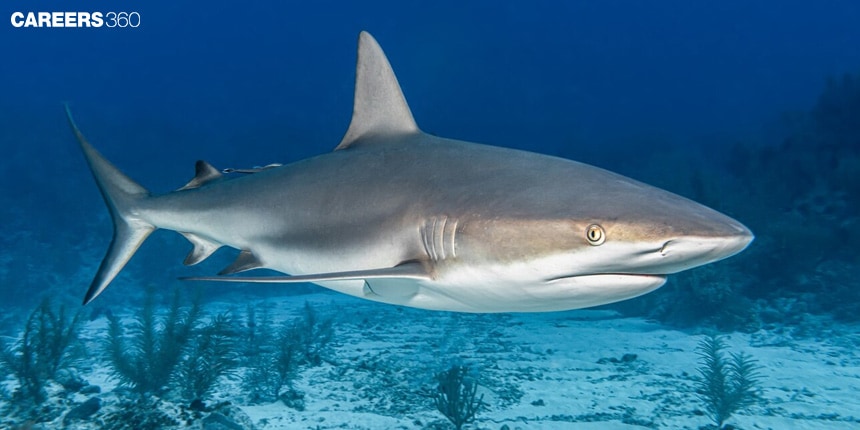Chondrichthyes - Definition, Classification, Characteristics, Examples & Facts
Chondrichthyes are cartilaginous fishes, which comprise sharks, rays, skates, and chimaeras, featuring skeletons made from cartilage rather than bone. Such characteristics as placoid scales, electroreceptive organs, and streamlined bodies make them important predators and scavengers in their aquatic habitats. They have evolved from about 400 million years back and hence represent some of the critical timescales for the evolution of vertebrates. This is one of the topics from the Animal Kingdom Chapter in Biology.
NEET 2025: Mock Test Series | Syllabus | High Scoring Topics | PYQs
NEET Important PYQ's Subject wise: Physics | Chemistry | Biology
New: Meet Careers360 B.Tech/NEET Experts in your City | Book your Seat now
- What are Chondrichthyes?
- Chondrichthyes Classification
- Chondrichthyes characteristics
- Chondrichthyes Anatomy and Physiology
- Habitat and Distribution of Chondrichthyes
- Ecological Importance of Chondrichthyes

What are Chondrichthyes?
Class Chondrichththyes includes cartilaginous fish characterized by a skeleton made of cartilage rather than bone. Chondrichthyes are top predators and contribute a huge volume to marine ecosystem biomass. They play a central role in maintaining the health and biodiversity of Aquatic ecosystems.
Chondrichthyes Classification
Pisces is divided into two classes:
- Chondrichthyes- Cartilaginous fishes
- Osteichthyes- Bony fishes
| Kingdom | Animalia |
| Phylum | Chordata |
| Subphylum | Vertebrata |
| Division | Gnathostomata |
| Superclass | Pisces |
| Class | Chondrichthyes |
Chondrichthyes are divided into these subclasses:
Elasmobranchii (sharks, rays, and skates)
It has predatory and streamlined bodies with skeletons made of cartilage, many rows of teeth, and electroreceptive organs.
Examples: Great White Shark, Manta Ray.
Holocephali (chimaeras)
Unique, rabbit-like faces with specialised dental plates; single gill opening.
Examples: Ratfish, Ghost Shark.
Chondrichthyes characteristics
The skeleton is composed of cartilage instead of bone, providing flexibility and durability.
The tooth-like overlapping scales help reduce drag, hence improving swimming efficiency.
It has different fin shapes that allow for stability and survival.
No swim bladder, yet buoyancy is maintained by large livers filled with oil.
Respiration: Efficient oxygen extraction from water is possible through the gill slits while some species with spiracles, which are respiratory organs usually used while resting on the ocean floor.
Control of buoyancy: The liver stores oil changes to maintain buoyancy.
Osmoregulation: Ability to maintain constant internal salt concentrations in various marine environments.
Oviparous: The eggs are laid outside and develop outside the female's body, e.g., skates.
Ovoviviparous: The eggs hatch inside the female body, and are born live. Example: Most sharks.
Viviparous: Embryos develop inside the female. They get nourishment directly from the mother. Example: Some sharks.
Chondrichthyes Examples
The prominent examples of cartilaginous fishes are:
Rays
- Torpedo (Electric ray)
- Narcine bancroftii (Lesser electric ray)
- Trygon (Stingray)
- Manta (Manta ray)
Sharks
- Rhincodon (Whale shark)
- Scoliodon (Dogfish)
- Charcarodon charcharias (The great white shark)
Sawfishes
- Anoxypristis cuspidata (Narrow sawfish)
- Pristis clavata (Dwarf sawfish)
Skates
- Cruriraja andamanica (Andaman leg skate)
- Leucoraja erinacea (Little skate)
- Gurgesiella (Small deepwater skate)
Chimaeras
- Callorhinchus milii (Australian ghost shark)
- Hydrolagus alphus (Whitespot ghost shark)
- Chimaera argiloba (Whitefin chimaera)
Chondrichthyes Anatomy and Physiology
The skeletons of Chondrichthyes, like sharks, are cartilaginous, combining flexibility and strength.
Their external characteristics include fins for steering and propulsion, gills for breathing, and sensory organs such as the ampullae of Lorenzini, allowing for the detection of electrical fields.
Internally they have a spiral valve in their digestive system for efficient absorption of nutrients, and in the circulatory system, a two-chambered heart pumps blood through a closed system.
Their nervous system and sensory developments, such as the lateral line system, could enable the detection of surrounding vibrations and movement.
Habitat and Distribution of Chondrichthyes
Chondrichthyes, sharks included, have representatives in both the pelagic and benthic seafloor zones.
They are diversified across a broad spectrum of marine habitats that stretch from coral reefs to deep dark seabed trenches and shallow coastal waters.
Geographically, their distribution is worldwide, depending on factors such as temperature gradients, salinity levels, and food availability that determine the habitat they prefer.
Ecological Importance of Chondrichthyes
Chondrichthyes are top predators in regulating prey populations, hence maintaining ecological balances, and their effects eventually lead to biodiversity and the stability of ecosystems.
Their protection comes with sustainable fishing methods and protected marine areas as part of conservation efforts.
They are also challenged by overfishing, bycatch, habitat loss, and pollution.
Chondrichthyes are economically relevant through fisheries and, more recently, by ecotourism activities such as shark diving.
Understanding shark behaviour minimises human–shark conflicts in such a way that safety is well-balanced against conservation.
The arguments above, centred on conservation versus culling, comprising ethical and ecological considerations, are relevant to sustainable management.
Also Read:
Recommended video
Class Chondrichthyes:
Frequently Asked Questions (FAQs)
Chondrichthyes are characterized by a cartilaginous skeleton, placoid scales, and lack of a swim bladder.
Chondrichthyes exhibit oviparous, ovoviviparous, and viviparous reproductive modes depending on the species.
Examples include the Great White Shark, Manta Ray, and Ratfish.
They play a crucial role in maintaining marine biodiversity and stability through their roles as predators.
Major threats include overfishing, habitat loss, and pollution.
Also Read
29 Nov'24 12:52 PM
26 Nov'24 04:23 PM
26 Nov'24 04:19 PM